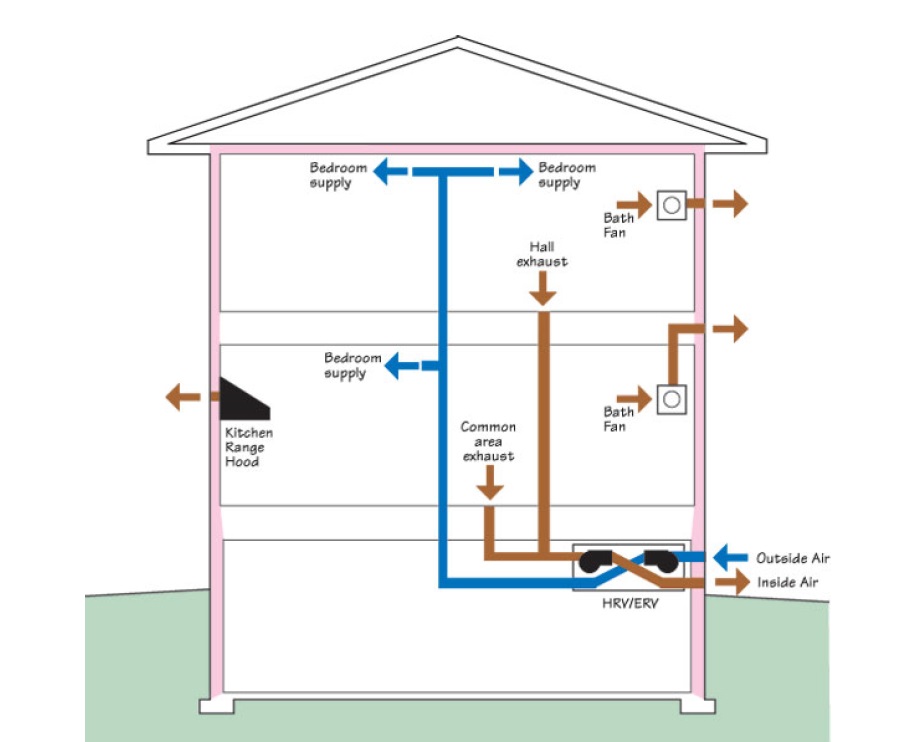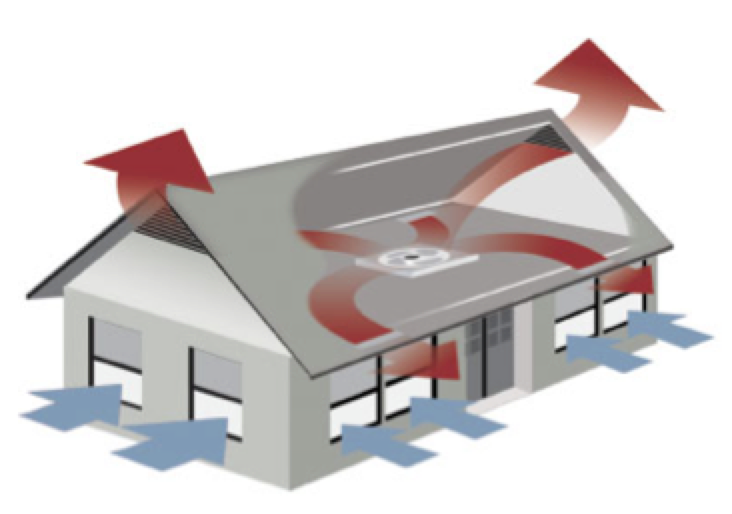Home Ventilation Melbourne: A Smart Investment for Modern Living
Exploring Ingenious Solutions for Optimal Home Ventilation Solutions
Home air flow plays an essential duty in preserving health and wellness and convenience within living rooms. With advancements in technology, innovative solutions are emerging to maximize these systems. Smart air flow, energy recovery ventilators, and advanced filtration are reshaping just how air quality is taken care of - Home Ventilation Melbourne. However, the combination of these technologies questions regarding their efficiency and adaptability in varied home environments. What effects do these growths hold for future living standards?
The Relevance of Home Ventilation for Health And Wellness and Convenience
Frequently neglected, home ventilation plays a vital role in maintaining both health and comfort within domestic spaces. Adequate air flow is crucial for the circulation of fresh air, which assists to thin down indoor contaminants such as volatile natural substances, allergens, and smells. Without proper airflow, these impurities can gather, bring about respiratory system concerns and other health issue. Additionally, effective air flow adds to controling humidity levels, avoiding mold growth and architectural damages. By making certain a well balanced exchange of air, residents can take pleasure in an extra positive interior setting, boosting overall well-being. Moreover, adequate air flow can enhance energy effectiveness by decreasing the need for too much heating or cooling, ultimately causing reduced utility bills and an extra sustainable home.
Smart Ventilation Solutions: Harnessing Modern Technology for Efficiency
Smart ventilation systems represent a significant innovation in home air management, leveraging IoT combination for boosted control. These systems not only promote power performance however likewise supply remote monitoring capacities, allowing customers to optimize their indoor settings effortlessly. By using technology, homeowners can achieve improved air quality while decreasing energy usage.
IoT Combination Advantages
Exactly how can IoT integration transform traditional air flow systems into highly efficient clever options? By incorporating Web of Things (IoT) innovation, ventilation systems can achieve real-time monitoring and control, enhancing their functional performance. Sensing units put throughout a home collect data on air top quality, humidity, and temperature, permitting automated modifications based on existing problems. This immediate responsiveness leads to improved indoor air quality and comfort levels. Furthermore, IoT-enabled systems can interact with various other clever home gadgets, developing a natural environment that maximizes power use. Individuals can additionally gain access to and handle their ventilation systems remotely by means of mobile phones, offering benefit and boosted control. Generally, IoT combination stands for a considerable advancement, bringing intelligence and flexibility to typical air flow practices.
Power Efficiency Features
As power efficiency becomes a vital emphasis in modern home layout, progressed air flow systems use ingenious functions that substantially reduce energy usage. These smart ventilation systems utilize sensors to keep track of interior air moisture, quality, and temperature level levels, immediately readjusting air movement to preserve optimal conditions. By using energy recuperation ventilators (ERVs), they catch and reuse power from outgoing air, reducing heating and cooling demands. Variable speed fans better enhance effectiveness by changing their procedure based upon real-time needs, stopping unneeded energy waste - Home Ventilation Melbourne. Furthermore, programmable timers and tenancy sensing units ensure that air flow operates just when required, adding to lower energy bills. Jointly, these features represent a significant advancement in producing energy-efficient and sustainable living atmospheres
Remote Tracking Capabilities
What advantages do remote monitoring abilities offer modern-day home ventilation systems? These abilities permit home owners to track interior air high quality and system efficiency in actual time, enhancing overall effectiveness. By supplying data on air, temperature, and moisture toxins, wise ventilation systems make it possible for aggressive modifications, ensuring ideal problems. In enhancement, remote tracking helps with maintenance signals, determining prospective problems before they escalate, consequently reducing repair costs and downtime. Users can access system analytics through mobile applications, enabling hassle-free control also when away from home. This technical combination not just advertises power effectiveness but additionally adds to a much healthier living setting. Eventually, remote surveillance capacities represent a considerable improvement in home ventilation, aligning with the growing need for smart home technologies.
Energy Recuperation Ventilators: Optimizing Power Cost Savings
Energy recovery ventilators (ERVs) play a crucial duty in boosting home power effectiveness via reliable warmth exchange. By transferring thermal energy in between inbound and outgoing air, these systems markedly minimize overall energy usage. This ingenious strategy not just keeps interior air top quality but likewise adds to decrease energy costs.
Efficiency of Warm Exchange
While keeping interior air high quality is important for wellness and comfort, the effectiveness of heat exchange in energy recuperation ventilators (ERVs) plays a crucial role in optimizing energy cost savings. The primary function of an ERV is to transfer warmth and wetness in between outgoing and inbound air streams, navigate to this site which enhances interior problems while decreasing energy loss. High-efficiency warm exchangers can substantially minimize the tons on heating and cooling down systems by redeeming power that would certainly otherwise be thrown away. The efficiency of these systems is usually gauged by their core temperature level currency exchange rate, which can differ based upon style and products made use of. By concentrating on sophisticated warmth exchange technologies, home owners can improve their ventilation systems, causing boosted energy performance and price decreases gradually.
Decreased Energy Intake
Lowering power usage is an essential advantage of energy recovery ventilators (ERVs), as they effectively reuse thermal power from worn down air. By transferring heat between outbound and incoming air streams, ERVs decrease the demand for added home heating or air conditioning, bring about considerable power financial savings. This procedure not only lowers utility prices however also decreases the ecological impact connected with greater energy usage. Furthermore, ERVs maintain regular interior air quality without endangering thermal convenience, producing a well balanced living atmosphere. By integrating ERVs into home air flow systems, homeowners can accomplish higher energy efficiency, enabling a lasting strategy to interior air management while gaining from reduced energy expenses. Inevitably, ERVs represent an engaging solution for energy-conscious customers.
Advanced Filtration Technologies for Cleaner Indoor Air
As interior air quality comes to be progressively identified as an essential element of health and health, progressed filtration technologies are becoming vital tools for making certain cleaner settings. These innovations consist of high-efficiency particulate air (HEPA) filters, turned on carbon filters, and electrostatic precipitators, each made to effectively record airborne toxins, irritants, and volatile organic compounds (VOCs) HEPA filters can trap bits as little as 0.3 microns, significantly lowering irritants like allergen and pet dander. Triggered carbon filters master adsorbing odors and chemical vapors, adding to a fresher interior environment. In addition, electrostatic precipitators make use of electric fees to eliminate fragments, giving an energy-efficient alternative. By integrating these innovative purification systems, home owners can enhance indoor air high quality and promote much healthier space.
The Duty of Sensing Units in Optimizing Airflow and Quality
Exactly how can sensors transform the administration of indoor air top quality? Sensing units play a necessary role in enhancing air movement and improving indoor environments. By constantly monitoring elements such as moisture, temperature, and levels of toxins, they supply real-time data that notifies ventilation systems. This info allows computerized modifications to airflow, making sure ample circulation and minimizing the buildup of contaminants. In addition, progressed sensors can identify certain air quality concerns, motivating prompt responses to improve convenience and health. The combination of these devices into ventilation systems permits a much more advice efficient and responsive management strategy, reducing power usage while maintaining suitable air high quality. Ultimately, sensors act as a vital part in producing much healthier indoor rooms with accurate air movement law.
Incorporating Air Flow With Smart Home Equipments
While numerous home owners look for comfort and efficiency, incorporating ventilation systems with wise home modern technology offers an ingenious remedy to managing indoor air top quality. By attaching ventilation systems to wise home centers, homeowners can automate air quality surveillance and control airflow based on real-time data. These systems can react to adjustments in contaminant, temperature level, and moisture levels, making certain optimal indoor conditions. Smart thermostats can operate in tandem published here with air flow systems to enhance energy effectiveness, reducing prices while maintaining comfort. Home owners can likewise from another location manage their ventilation settings through mobile apps, providing flexibility and comfort. Inevitably, this assimilation not just streamlines administration however considerably enhances the overall living environment, making it an important addition to modern homes.
Future Fads in Home Air Flow Solutions
Emerging technologies and heightened recognition of interior air quality are shaping the future of home ventilation remedies. One considerable pattern is the integration of expert system, making it possible for systems to change air movement based on real-time data and occupancy patterns. On top of that, power recuperation ventilators are getting grip, offering efficient air exchange while lessening energy loss. Making use of environment-friendly materials and designs is also increasing, aligning with sustainability objectives. Smart sensing units that monitor contaminants and humidity degrees are ending up being standard, permitting house owners to maintain excellent interior environments. Modular and scalable systems are emerging, providing adjustable alternatives for different home dimensions and configurations. With each other, these advancements guarantee to enhance comfort, performance, and health in household spaces
Often Asked Inquiries
How Often Should I Tidy My Home Air Flow System?

The regularity of cleaning a home air flow system varies based upon usage and setting. Normally, it is suggested to clean the system every 3 to six months to maintain perfect air quality and system efficiency.
Can Poor Air Flow Cause Mold And Mildew Growth Indoors?

What Are the Indications of Inadequate Home Air Flow?
Indications of inadequate home air flow include persistent smells, enhanced humidity degrees, condensation on home windows, visible mold development, and a basic feeling of stuffiness. These indicators often recommend that air circulation wants for preserving a healthy and balanced indoor setting.
How Can I Boost Ventilation in Older Houses?
To boost ventilation in older homes, one could take into consideration installing exhaust followers, utilizing natural airflow through home windows, sealing voids for far better air control, and integrating air cleansers to enhance interior air top quality efficiently.
Are Do It Yourself Ventilation Solutions Effective and Safe?

Smart air flow, power recuperation ventilators, and progressed filtering are reshaping exactly how air high quality is handled. As power performance ends up being an important focus in modern home layout, advanced ventilation systems use innovative attributes that significantly lower power intake. By incorporating ERVs right into home ventilation systems, house owners can accomplish higher energy effectiveness, making it possible for a lasting method to indoor air management while profiting from reduced energy expenses. The combination of these gadgets into air flow systems allows for a much more reliable and receptive monitoring technique, lowering energy consumption while maintaining excellent air top quality. While lots of house owners look for benefit and effectiveness, incorporating ventilation systems with wise home technology offers a cutting-edge option to handling interior air top quality.